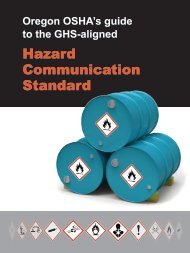Technical Manual - Section 3 (Safety Hazards)
Technical Manual - Section 3 (Safety Hazards)
Technical Manual - Section 3 (Safety Hazards)
Create successful ePaper yourself
Turn your PDF publications into a flip-book with our unique Google optimized e-Paper software.
Table III:2-8 SOLVENT DEWAXING PROCESS<br />
Feedstocks From Process Typical products................To<br />
Lube basestock Vacuum tower Treating Dewaxed lubes or wax....... Hydrotreating<br />
Spent agents....................... Treatment or recycle<br />
SOLVENT DEWAXING<br />
Solvent dewaxing is used to remove wax from either distillate<br />
or residual basestocks at any stage in the refining process.<br />
There are several processes in use for solvent dewaxing, but<br />
all have the same general steps, which are: (1) mixing the<br />
feedstock with a solvent, (2) precipitating the wax from the<br />
mixture by chilling, and (3) recovering the solvent from the<br />
wax and dewaxed oil for recycling by distillation and steam<br />
stripping. Usually two solvents are used: toluene, which<br />
dissolves the oil and maintains fluidity at low temperatures,<br />
and methyl ethyl ketone (MEK), which dissolves little wax at<br />
low temperatures and acts as a wax precipitating agent. Other<br />
solvents that are sometimes used include benzene, methyl<br />
isobutyl ketone, propane, petroleum naphtha, ethylene<br />
dichloride, methylene chloride, and<br />
sulfur dioxide. In addition, there is a catalytic process used<br />
as an alternate to solvent dewaxing.<br />
HEALTH AND SAFETY CONSIDERATIONS<br />
Fire Prevention and Protection<br />
Solvent treatment is essentially a closed process and,<br />
although operating pressures are relatively low, the potential<br />
exists for fire from a leak or spill contacting a source of<br />
ignition such as the drier or extraction heater. In solvent<br />
dewaxing, disruption of the vacuum will create a potential<br />
fire hazard by allowing air to enter the unit.<br />
Health<br />
Because solvent extraction is a closed process, exposures are<br />
expected to be minimal under normal operating conditions.<br />
However, there is a potential for<br />
exposure to extraction solvents<br />
such as phenol, furfural, glycols,<br />
methyl ethyl ketone, amines, and<br />
other process chemicals. Safe work<br />
practices and/or the use of<br />
appropriate personal protective<br />
equipment may be needed for<br />
exposures to chemicals and other<br />
hazards such as noise and heat, and<br />
during repair, inspection,<br />
maintenance, and turnaround<br />
activities.<br />
III:2-22
















